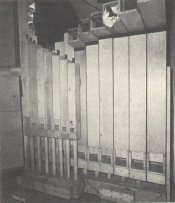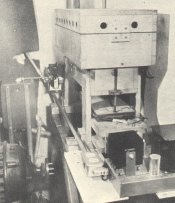


20th Century Theatre - 2/8 Kimball
Juneau, Alaska
222 Front St. - Triangle Building
Organ installation timeframe: 1939-1976
Back to the Alaska Original Theatre Installations page
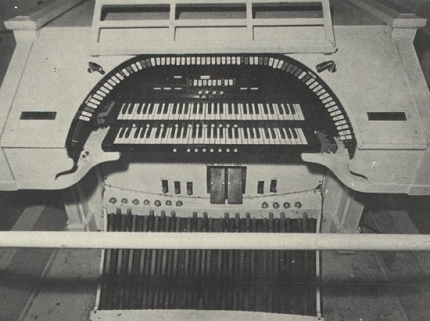
Console of the 20th Century Theatre 2/8 Kimball, c.1963
The 20th Century Theatre was built in 1939 by W.D. Gross. A Kimball organ, originally from Juneau's Coliseum Theatre (also owned by Mr. Gross), was moved to the 20th Century Theatre in the early 1940's.
In 1976-77, the organ was relocated to Juneau's State Office Building by Balcom & Vaughan.
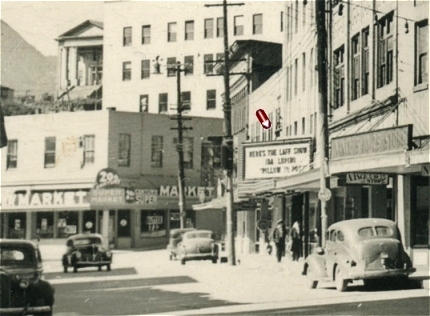
Front Street, glimpse of the 20th Century Theatre marquee on right, 1945
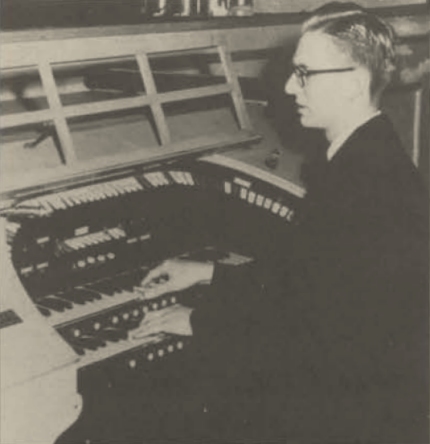
Franklin Butte at the console, 1954
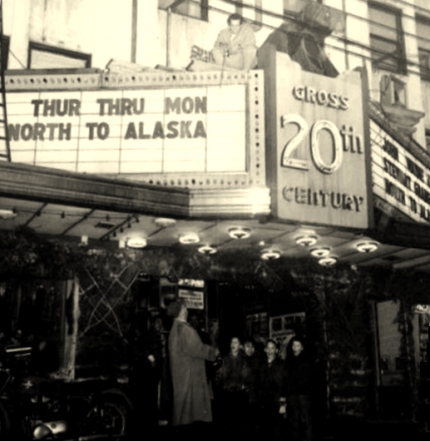
20th Century marquee, c.1960
The following is an edited version of an article in Theatre Organ, Fall 1963 (V5 No 3, pp10-11) written by J. Allan MacKinnon:
![]() Editor's note: several dates in the original article were incorrect. In July 2000, Mr. MacKinnon provided updated information. The correct dates are included below.
Editor's note: several dates in the original article were incorrect. In July 2000, Mr. MacKinnon provided updated information. The correct dates are included below.
Juneau, Alaska Hears Organ
By J. Allan MacKinnon
The roaring twenties are gone, but their many glorious theatre organs are left today throughout the United States ...even in Alaska.
Two Kimball theatre organs are left in the 49th state. One is in a Fairbanks theatre. This organ had its main cables cut by accident but is in perfect condition otherwise. The other organ, in Juneau, is located in the Twentieth Century Theatre, and is in working order.
Following is a brief account of the history of this organ, the changes that have been made, and what is hoped to be done to it in the near future.
In 1928, W. D. Gross, pioneer Alaskan and founder of the motion picture industry in Alaska, purchased a 2/8 Kimball for his Coliseum Theatre in Juneau.
The organ was rarely if ever used for many years until 1951, when Franklin Butte, a radio engineer from Portland, Oregon, was engaged at one of the local radio stations. He took an immediate interest in the organ and devoted much of his free time to its rehabilitation.
The console of the organ located in the slight pit had its main cables running along the cement floor under the stage, so during the thirteen years that the organ sat in this position, the cables eventually became water soaked and began to rot, with the result that many wires shorted out. Besides water damage, rats in the theatre were using the exposed wiring in the rear of the console for nests. Consequently, a good deal of the organ had become inoperative.
This was bad for the organ, for most of the sound from the pipes escaped through the holes in the ceiling resulting from this alteration instead of being projected into the auditorium. Three rows of seats were removed, and the organ pit was extended farther into the seating on the main floor.
The traps located in the right loft were slightly damaged during this reconstruction and so were disconnected and moved to the main stage and finally to the left loft with the main organ. Not having high enough pressure, they did not work satisfactorily in this position. The Kimball upright piano was also moved at this time to the main floor of the auditorium.
This was the condition of the organ until the summer of 1961, when I was employed by the theatre as doorman.
Having gained some former experience by assisting with the installation of another pipe organ in Juneau, and having a great love for the organ, I spent every available moment working on this instrument.
Being only seventeen years old and not an "old pro" in the business of theatre organs, I consulted with Franklin as to what could be done to improve the 20th Century's organ. He was quite busy at the time, so one of the theatre maintenance men, Robert Gregg, volunteered to help me in his free time. Bob had never worked on an organ before, but given a problem he can usually come up with several practical ways of solving it.
Our first project was to move the traps back to their original position in the right loft under higher wind pressure and with no expression. This we accomplished in a week's time, working when we could. Franklin Butte was called in to play the first intermission music. For the first few times we left the grill cloth off the loft and many folks, especially the children, were disappointed when we replaced it to reduce the harsh volume of the drums.
The next thing we did was to retrieve the 73 trumpets which had been moved to one of the local churches. We replaced these and completely tuned the instrument. Tracing wiring and rewiring into the console took considerable time.
The pedals were in such deplorable condition that I built a direct electric relay using new relays, the old pneumatic stop switches and new contact blocks under the pedals. With the help of Mr. Gregg, we finally got it wired into the pedals so that every note works.
[picture caption] Lower 18 notes of Bourdon that have been mounted on dolly and temporarily
placed back of screen, 20th Century Theatre, Juneau.
At this time we added the Cornet 49 into the pedal which had no stop tablet on the console, but was provided with a stop switch.
One interesting feature is that the bottom eighteen notes of the pedal Boutdon are mounted on a dolly. This dolly we constructed so we could use the pipes, as well as make room in the right loft where they had been stored. This dolly we have placed on the stage directly behind the screen and have connected it with flexiduct and a twenty prong plug. If it should become necessary to move or disconnect it entirely for a stage production, it can be done.
The only other project that we have worked on is to relocate the two rank, 61 note ventil chest, holding the Diapason and Clarinet, to a position at the front of the main chamber and
directly behind the swell shades.
The location of the main chest makes it impossible for many of the upper harmonics of the organ to sound out. The sound from the organ turns a very sharp corner in order to escape through the opening. Further blocking the sound are the pipes in the lower extension of the Tibia. Not only that, but the pedal Tibia and expression shades are on the main reservoir. This creates a drag on the main air, tremulant, and expression.
It is my aim to work on relocating most of the organ in the front portion of the main chamber, with the pedal pipes in the rear. This would greatly increase the tonal resources of the instrument.
We also hope to obtain a set of expression shutters to put the traps and percussion under expression.
On the whole, the organ is in great condition, although there is some wiring yet to be done. All the pipes are in near perfect condition except two bent violin pipes.
The console is a two manual horseshoe painted a dull white which really makes it look very sharp, especially under a bright spotlight.
There are eight ranks of pipes, this being one of the common sizes made by Kimball. The name and number of pipes follows:
Tibia, 85 pipes
Concert Flute, 85 pipes
Trumpet, 73 pipes
Violin, 85 pipes
Vox Humana, 61 pipes
Kinura, 61 pipes
Horn Diapason, 61 pipes
Clarinet, 61 pipes
This makes a total of 572 pipes.
The organ is played before each special attraction; during intermission, when there is just one showing of a feature; and on regular Saturday and Sunday night spots. We frequently use the organ for background through the titles of a special show if appropriate music is available.
The one outstanding and unusual part of the organ at the 20th is the upright Kimball piano. This is one of the few exposed pianos. It also has a spotlight relayed upon it whenever used. The piano is frequently used with the "tin pan" effect as a feature number in a program.
This is one theatre organ that will not be torn out as long as the manager, W. Ray Howes, is in charge. Mr. Howes is a great enthusiast, and encourages the frequent use of the organ. It is used every Thanksgiving, and on Good Friday, when the theatre is donated for the gathering together of the people of Juneau.
One of the biggest recitals on this organ occurred during a recent concert of all local artists from Juneau. The second to the last number on the program was considered by everyone as the highlight of the show. It was then that Franklin Butte took his place at the console. The bright lights dimmed, the amber spot shone on the white console, and a medley of tunes from the great shows was heard. The theatre was extremely quiet, with just the beautiful tones of the Grand Kimball filling the one thousand and one seat auditorium. Beginning with "The Sound of Music," and ending with "You'll Never Walk Alone", the ten minute medley sent a tingling sensation through everyone. The audience, for the first time in many years, was hearing the glorious full tones of the Mighty Kimball, finally renewed for the further enjoyment of all.
Interestingly, the 20th Century Theatre actually shares a concrete fire wall with the Palace (Capitol) Theatre on the opposite side of the Triangle Building as shown here:
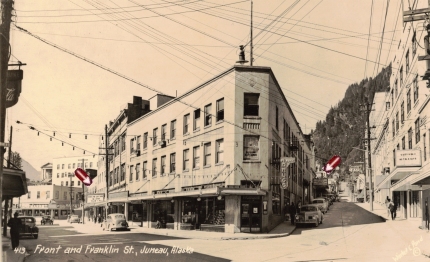
c.1945
About this site © PSTOS, 1998-2025
